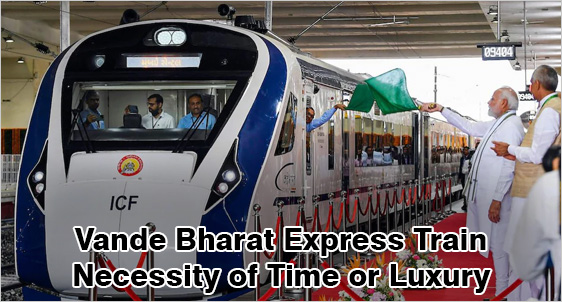
Vande Bharat Express Train: Necessity of Time or Luxury
Vande Bharat Express, previously known as Train 18, is a semi-high-speed electric multiple unit train operated by Indian Railways on 6 routes as of December 2022. The declaration of plan to undertake indigenous manufacture of 400 new generation Vande Bharat express trains at Rs 130 crores in the recent budget for 22-23 presented by Finance Minister was welcomed by most analysts. Yet, there are some critics on Vande Bharat Express Trains. Government wants to showcase the Vande Bharat Express Production as ‘Make in India’ success story. Critics of Vande Bharat Express Services argue that Government must prioritize other social goals like food and education, and not create ‘luxuries’ like Vande Bharat Express trains that only rich can afford. Given the importance of this development of Vande Bharat Express Services, it is expected to be a hot GD and WAT Topic for Admission 2023 and beyond. MBAUniverse.com presents a review of this important GD Topic on Vande Bharat Express Train.
Also Read
Why Vande Bharat is important - Background
India had since long planned to introduce a high-speed rail network. Safety and cost were the primary concerns for the Indian railways. Indian Railways went on to achieve speeds of 99 mph by the mid-2010s after the introduction of Gatimaan Express in 2016. The next logical step for Indian Railways was to build a modern higher-speed rail. When the Indian railways had floated a tender in June 2015, they found none of the bids to be viable and hence decided to move ahead to begin the Vande Bharat Express Manufacturing first set and if successfully inaugurated, to go ahead with further produce the Vande Bharat Express Train versions on various routes completely in India. In early 2017, it was planned that the indigenous (EMU) semi-high-speed train, with modern facilities onboard, would run at a speed of 160 km/h (99 mph). Two new train sets were announced to be manufactured in ICF and were named 'Train-2018' since the manufacturing of these semi-high-speed services were targeted for completion in the year 2018.
After four years of planning, manufacturing, and testing, Train 18, now Vande Bharat Express Inauguration was done on 15 February 2019. The first Vande Bharat Express Route (Named Train 18 at that time) was from New Delhi to Varanasi. Soon Train 18 was renamed as 'Vande Bharat Express' by Railway minister. The Prime Minister Narendra Modi flagged off the Vande Bharat Express inaugural run-on 15 February 2019, with its commercial run starting from 17 February 2019. The first Vande Bharat Express route is from Delhi to Varanasi, via Kanpur and Prayagraj, connecting the holy city of Varanasi to the Capital city, reducing travel time along the route by 15%.
What are Vande Bharat Trains?
What are the Features of the Vande Bharat Trains?
What are the Features of Vande Bharat 2.0?
Vande Bharat Express Train versions
|
Originating station
|
Terminal station
|
Train Name
|
Distance
|
Inauguration
|
Major Halts Only
|
|
New Delhi
|
Varanasi Junction
|
New Delhi - Varanasi Vande Bharat Express
|
759 km (472 mi)
|
15-Feb-19
|
Kanpur Central and Prayagraj Junction
|
|
New Delhi
|
Shri Mata Vaishno Devi Katra
|
New Delhi - Shri Mata Vaishno Devi Katra Vande Bharat Express
|
655 km (407 mi)
|
03-Oct-19
|
Ludhiana Junction and Jammu Tawi
|
|
Mumbai Central
|
Gandhinagar Capital
|
Mumbai Central - Gandhinagar Capital Vande Bharat Express
|
522 km (324 mi)
|
30-Sep-22
|
Vapi, Surat, Vadodara Junction and Ahmedabad Junction
|
|
New Delhi
|
Amb Andaura
|
New Delhi - Amb Andaura Vande Bharat Express
|
412 km (256 mi)
|
13-Oct-22
|
Chandigarh Junction
|
|
MGR Chennai Central
|
Mysuru Junction
|
MGR Chennai Central - Mysuru Vande Bharat Express
|
496 km (308 mi)
|
11-Nov-22
|
Katpadi Junction and KSR Bengaluru
|
|
Bilaspur Junction
|
Nagpur Junction
|
Bilaspur - Nagpur Vande Bharat Express
|
412 km (256 mi)
|
11 December 2022[82]
|
Raipur Junction, Durg Junction, Rajnandgaon and Gondia Junction[83]
|
Challenges
With the latest edition of the Vande Bharat train, India made a huge leap into the future of mass transportation. However, it has also raised questions, as the poor may not be able to afford these trains. Vande Bharats are sleek, modern trains; but are currently being run at much less the design speed. In the coming months, travel time on the Vande Bharat will need to be reduced. As is the case, traditional loco-hauled trains already have the capability to run at speeds of 160 kmph but are being operated at lesser speed because of the absence of matching infrastructure.
Also Check Latest Group Discussion GD Topics
Exam 2024 Notification